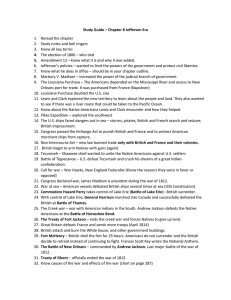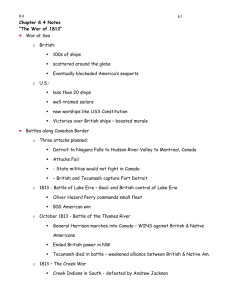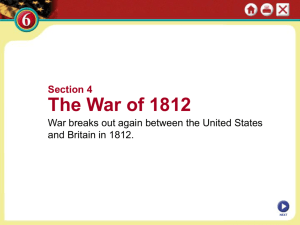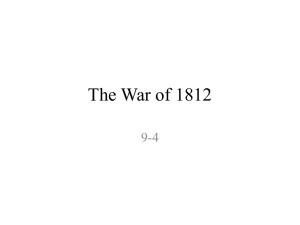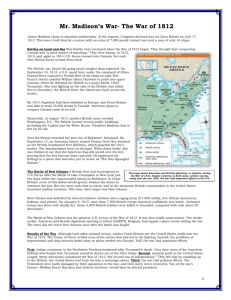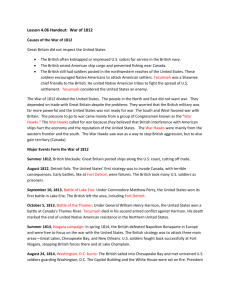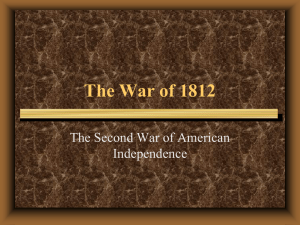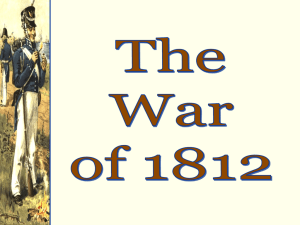War of 1812 - Mr. Cvelbar's US History Page
advertisement
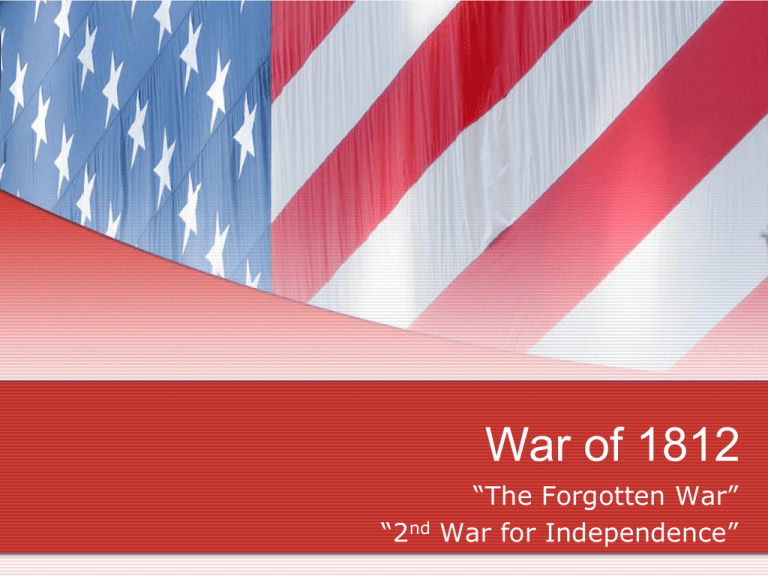
War of 1812 “2nd “The Forgotten War” War for Independence” James Madison • Virginian • Republican • “Father of the Constitution” • Former Secretary of State under TJ • Elected president in 1808 Call to War • Madison calls Congress to declare war on Britain in 1812 • Impressments of American sailors • Britain needed troops to fight Napoleon and the French • British backing of Indian uprisings on the Frontier • Congress declares war on Britain • June 1812 • First time Congress declares war • Britain actually revoked Impressment Act 2 days before war was declared • Word had not yet reached United States 1812 – Sea Battles • In 1812, British had 97 naval vessels in American waters • Americans had 22 • US Navy was depleted under Jefferson • Madison called for privateers • Privately owned ships • “cheapest and best navy” Comparison of Navy vs Privateers during War of 1812 U.S. Navy Privateers 23 517 Total guns on ships 556 2893 Enemy ships captured 254 1300 Total ships Sea Battles USS Constitution • One of the first ships built by the US Navy • Commanded by Isaac Hull • Copper sheathing on the hull, spikes, and bolts made by Paul Revere • Left Chesapeake Bay in June after declaration of war • Chased by British ships • Met the HMS Guerriere off the coast of Nova Scotia on August 19th Sea Battles “Old Ironsides” Painting of combat between USS Constitution and HMS Guerriere by Michel Felice Corne Sea Battles “Old Ironsides” • Hull fired his guns at 25 yards ravaging the Guerriere • British commander returned fire but was amazed at how his cannon shot bounced harmlessly off the Constitution’s hull • Earned nickname “Old Ironsides” • Ships collide three times during the battle • 3rd collision knocked over Guerriere’s mast • Hull burns HMS Guerriere and returns to American a hero Sea Battles US Sea Power • American dominated the seas in 1812 • Victories by the USS Constitution, USS United States • Successful American privateers • Captured over 1,000 British ships by war’s end • By 1813, Britain deployed more ships and blockaded US ports • Docking many US ships until the war’s end • Overpowering American ports • Able to land troops on American shores The Northern Front Invasion of Canada/Northwest Territory • As battle is raging at sea, US decides to attack British held Canada in July of 1812 • Closest way to engage the British army • Thought it would be a “mere matter of marching” • Small British army joined with Tecumseh to defeat weak and ill-prepared American invasion • British and Indian forces then marched South into Northwest Territory • Defeated Americans at Fort Dearborn, Mackinac, and Detroit • Fort Dearborn Massacre • Michigan, Wacker • Initial invasion = disaster The Northern Front – Burning of York • Americans were ready for the campaigning season in 1813 quicker than the British • 2,000 Americans set off in April for York (now Toronto), Canada’s capital • Attacked weakly defended city on April 27th • 700 British • 320 American casualties (including General Zebulon Pike) • British explode several of their own ships and kill over 100 Americans • 150 British • British surrendered city on April 28th • Americans burned many Gov. buildings including Parliament The Northern Front Holding our Ground • 1813 saw British forces team with Tecumseh and attempt to take US forts in Ohio • Americans repelled British at Fort Meigs (May), Fort Stephenson (August) • William Henry Harrison led a ragtag group of 4500 KY militia to retake Great Lakes region • Regained Fort Detroit • Marched into Canada The Northern Front Battle of Lake Erie • • Sept. 10, 1813 Oliver Hazard Perry commanded 9 US vessels on Lake Erie • • • • Perry commands from the USS Lawrence The Lawrence inflicts heavy damage upon the British fleet but is also heavily damaged and surrenders • • • • • Faced 6 British ships A ship building race started in January Meanwhile, Perry is rowed under heavy fire to resume command on the USS Niagara The Niagara is able to defeat HMS Detroit and forces Barclay to surrender All other British ships were captured or destroyed Decisive American victory Gave US control of Lake Erie for remainder of the war Battle of Lake Erie by William H. Powell “Dear General: We have met the enemy and they are ours…” The Northern Front Battle of Thames • Oct. 5, 1813 • Harrison had been pursing British and Indian forces and caught up with them at Moraviantown on the Thames River • Reinforced by troops sent by Perry • After breaking through initial Indian resistance, Harrison engaged a larger group of British regulars and Indians • Americans broke through British lines • British cannon failed to fire and they retreated • Tecumseh and his men stayed and kept up the fight • During fierce fighting in swampy terrain, Tecumseh was killed • Remainder of Indian forces dissolved Death of Tecumseh The Eastern Front 1814 - Here come the Redcoats… • Britain defeats Napoleon in 1814, freeing up the rest of their army for an American attack • Britain lands in the Chesapeake Bay and marches towards Washington DC • 6,500 American militia under William Winder meet 4,500 British 6 miles outside city in Bladensburg, MD The Eastern Front Bladensburg Races • August 24th 1814 • Seasoned Redcoats under General Robert Ross cut through inexperienced lines of militia • American retreat was so fast, the “battle” came to be known as the Bladensburg races • British continued their march to Washington • Government evacuated city • Dolley Madison remained to save as much from the White House as possible The Eastern Front Burning of Washington DC • British marched into Washington and burned the city • Library of Congress, Capitol, White House • No official American resistance • Hurricane and tornado swept through the capital that night ravaging the British and putting out the flames The Eastern Front Burning of Washington DC The Eastern Front Battle of Baltimore • British marched south to Baltimore • Planned a two-prong attack • Land attack from the north, sea attack from the south • On September 12th, British general Robert Ross arrived on the outskirts of town and began the push into the city • Initial British advancement was halted when Ross was killed by American sharpshooter • Americans had superior numbers and were well prepared for attack • British stopped their advance to wait for results of sea battle The Eastern Front Baltimore’s Defenses • Baltimore was protected to the south by Fort McHenry The Eastern Front Fort McHenry • Baltimore was protected to the south by Fort McHenry • Americans had sunk old merchant ships at the mouth of the harbor to prevent British ships from advancing towards Baltimore • 1000 Americans held Fort McHenry • 19 British ships under Arthur Brooks advanced towards the Fort and began trading cannon and mortar fire with Americans • The British ships backed out of range of the fort’s cannon and bombarded it with rockets, cannon, and mortar fire for 25 hours The Eastern Front Fort McHenry • After a ferocious night of bombardment, the sun rose on September 14th to find the oversized American Flag still waving above the fort • The British had fired an estimated 1800 cannonballs at Fort McHenry • The British gave up their attack • Sailed back out to sea to regroup Star Spangled Banner • An American citizen named Francis Scott Key was being held on one of the British vessels during the battle • The sight of the American Flag on the morning of Sept. 14th inspired Key to begin writing “In Defense of Fort McHenry” • Later to be called “The Star Spangled Banner” and become our national anthem • Set to tune of English drinking song "The Anacreontic Song" The Southern Front – Andrew Jackson • Born in SC, lived in TN • “Tough as old hickory” • Very tough on his men • Executed a militiaman for disobedience • Andrew Jackson had been commanding the TN militia against the Creek Indians • Creeks inspired by Tecumseh • Small battles throughout the war • Defeated Creek nation in Battle of Horseshoe Bend in March 1814 • Massacre; 800 of 1000 Red Sticks killed • Treaty of Fort Jackson forced the Creeks west into what is today Alabama • Indian Removal from the south had begun The Southern Front – New Orleans • After Baltimore, British regrouped and decided to launch an attack on New Orleans to take control of the Mississippi River • Andrew Jackson led a mix-matched group of 4,000 soldiers to defend the city • Army regulars, KY/TN/LA militia, Indians, free blacks, pirates • British landed off the coast of Louisiana on December 14th, 1814 • Several smaller skirmishes lead up to the main attack by the British on Jan. 8th The Southern Front – Attack on New Orleans • Jackson’s men built impressive earthworks next to the Mississippi called “Jackson’s Line” • Behind canal • On Jan. 8th British launched a 4 prong attack on the American lines • 8,000 redcoats • As three groups engaged different parts of the main line, a fourth group would sail up the Mississippi to outflank Jackson from south The Southern Front – The Battle of New Orleans • As the attack began the field was covered by heavy fog • As the British approached, the fog lifted, and they were met with stiff artillery fire from the Americans • British had forgotten ladders to scale earthworks • All three main attacks were repulsed • British suffered 2,037 casualties • Americans suffered 71 The Southern Front – Battle of New Orleans Battle of New Orleans by Herbert Morton Stoops Treaty of Ghent • Treaty signed on Dec. 24th 1814 in Ghent, Belgium • American commission headed by John Quincy Adams • Before Battle of New Orleans • Word of treaty had not yet reached generals • Restored things to pre-war status quo • Simply a mutual end to hostilities, return of prisoners, territory, etc. • Issues that started the war had resolved themselves by war’s end • British Impressment Act was repealed two days before War began • Defeat of the French in 1814 means that Impressment was no longer needed • Embargo/Non Intercourse Acts repealed • Indian Resistance quelled • Tecumseh killed • Followers crumbled without leadership • Jackson’s victories over the Creeks in the South Consequences • America had withstood its first real military test • Solidified its national identity • Affirmed American independence • Severely weakened Indian resistance to western expansion • Lost Tecumseh • Lost Britain as ally • Improved struggling economy from embargo • Increase in Home manufacturing • Exposed weaknesses of national defense • Madison soon recommended a 10,000 troop standing army (3 times the size under Jefferson) • More $ for military
